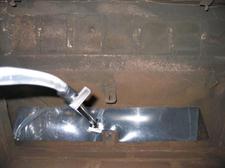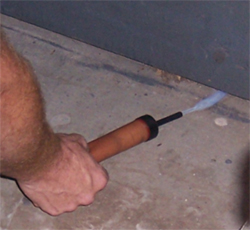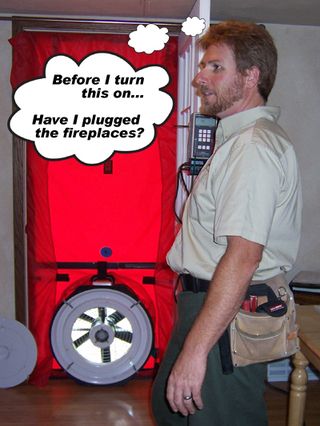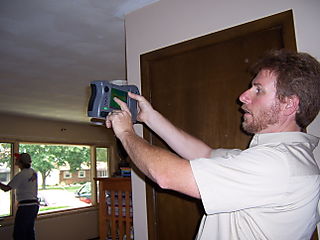
by blogediter | Apr 15, 2019 | Save Energy
Q: Jason, the cable that leads up to my Lymance chimney top damper seems to be puncturing my Chimney Balloon. I attached an image of the damper to show you where the cable is. -TP
A: TP- I see the cable as a very faint line just to the left of the Chimney Balloon valve in the picture. I see the cable runs along the edge of your metal damper there as well. What is happening is this cable is getting frayed over time as it rubs up and down against the metal edge of this damper opening. That frayed section of cable has little needle like protrusions and a flat side that is like a saw blade in roughness. I also notice that the Chimney Balloon is tight like a drum when installed. It is probably a little two tightly inflated.
Two things will help solve your issue here…
- Remove your Chimney Balloon and wrap packaging tape around your chimney top damper cable in the area the Chimney Balloon will come in contact with it. This will keep the flat sharp end of this cable from cutting the balloon.
- When you reinstall and inflate your Chimney Balloon do not fill it so tightly full with air. You can leave a little give in it. – Jason

by blogediter | Mar 20, 2019 | Save Energy
We did quite a bit of research on Smoke Pencils and smoke sticks before we selected one to be offered through our website. We tested and tried at least one of each variety that is on the market. We ended up going with the Smoke Pencil, but here are the pros and cons of each of the types of Smoke Pencils, Smoke Sticks, and Smoke Puffers.
Acid Based Smoke Puffers:
There are a few brand varieties of the acid based smoke puffers. The most common are the Retrotec and TT Smoke Sticks. They operate on a mixture of acids that create the chemical smoke.
Pro:
– The smoke consistency is very good for draft detection.
– The squeezable smoke sticks were nice (as pictured) because it was easier to control the quantity of smoke.
Cons:
– Because they are acid based you have to pay extra for hazardous material shipping via UPS
and the US mail will not ship them at all. This also presents an issue if you have to travel by plane with them to a work location. TSA will not allow them on commercial aircraft.
– The smoke is corrosive and irritating to the eyes and nose if you are working in a closed in areas like a drop ceiling or crawlspace.
– If exposed to excessive heat (like if you left them in your work truck on a hot day) the smoke pencils can sometimes “blowout or meltdown” so they are best kept away from your other tools and in a sealed container like a welding rod case. Don’t store them by your new IR camera.:)
MSRP Cost: around $60
Glycol and Glycerin Based Smoke Puffers
: These smoke pencils are battery operated smoke sticks. A very small internal heating element heats the Glycerin, Glycol & Water solution to produce a fine steam that looks like smoke.
Note: This was the type of Smoke Pencil we chose to sell on www.chimneyballoon.us.
Pros:
– The smoke is non-toxic, smells faintly sugary and is of a good consistency for draft testing.
– The smoke quantity and on/off feature is easy to control by the trigger on the device. They have a built-in LED light that helps illuminate the area you are testing.
– Batteries last a long time in this device but rechargeable batteries are recommended.
Cons:
– Some condensation takes place in the nozzle so after long periods of use you will have to empty the overfill tank that collects this condensation.
– The smoke fluid tank only holds about 1/2 oz of fluid so it sometimes requires more fluid between jobs.
– They are an allowable device by TSA on commercial flights, but they look suspiciously like drug paraphernalia on an x-ray scanner so expect that your package/luggage will get checked. If you are traveling by air with it keep some batteries handy and an MSDS sheet, since TSA will want to see the thing work and see the MSDS on it
MSRP Cost: Around $25
Silica Based Smoke Puffer:
This smoke puffer sold by Regin operates by jetting out a very fine silica powder. There are a variety of different silica puffer types that are larger with bulb type squeeze actuators and smaller bottle types (in the picture). They are often used in chemical lab environments since Silica is a relatively non-reactive substance.
Pro:
– The “smoke” is non-toxic. This item can easily be shipped or taken on a plane for travel without hassle.
Cons:
– Although the Silica is non-toxic it tends to hang in the air and cause sneezing and coughing.
– The powder also can be hard to see in poorly lit areas.
– The Silica powder will collect as dust on flat surface areas and make a bit of a mess.
– You cannot squeeze the bottle while upsizing down or it will spit out a flaky silica blob.
– Overall it is difficult to control the smoke quantity so you can detect drafts.
MSRP Cost: Around $10
Incense Sticks “The Makeshift Smoke Stick”:
Inevitably Rookie energy raters or homeowners will ask, “Why don’t you just use an incense stick to test for air sealing and drafts?”
Any Home performance Professional can tell you from experience that you don’t want to be inspecting a home with a lit incense stick in your hand. You are constantly moving stuff around and crawling around looking for air leakage. If you use an incense stick, inevitably you will set it down in the wrong place or have ash or an ember fall off of the stick and burn or stain the carpet, furniture or floor. Paying for a bo-bo like that makes the relatively inexpensive Smoke Pencil look like a pretty good investment. As a matter of fact keep a spare smoke stick handy in the service truck.
Pros:
–They are cheap, and you can buy them at any dollar store.
– The smoke is adequately visible.
Cons:
– They smell pungent and the smell hangs in the air.
– You run a very good chance of burning yourself or the carpet, furniture, etc… since you cant turn them off.
– They drop hot ash and embers.
– You can’t set them down while you work.
– They produce too much smoke.
MSRP Cost: Six for $1

by blogediter | Mar 4, 2019 | Save Energy
Blower Door Testing
I love going to tradeshows because it is a time that service professionals like Energy Raters and Chimney Sweeps can give us feedback on the applications that they use the Chimney Balloon in. At the 2009 ACI Conference in Kansas City, some energy auditors told us about how they use the Chimney Balloon to solve a very common fireplace soot issue during blower door testing.
Every rookie energy rater makes this mistake at least once. You go to a home to do an energy audit and just go straight to setting up the blower door kit. You look around the house and close up all the exterior doors and windows but completely neglect to look at the fireplaces. You fire up the blower door and suddenly notice a gathering grey soot cloud billowing from the living room. You know what you did wrong, you forgot to seal the fireplace. But it is too late…you already sucked a bunch of soot down the chimney and into the home. This makes the homeowner pretty ticked off and is not a good first impression.
Sometimes this even happens if you have the fireplace damper closed. Chimneys are filled with dust, and loose soot and metal dampers are notoriously leaky, so when you bring a house down to -50 pascal you can suck an enormous amount of air through the chimney and that will draw the loose soot and dust down too. It is like taking a drinking straw that has dust lined on the inside of it and briskly inhaling through it. *cough*cough*
The old school method is to take a wet towel and toss it over the ashes in the firebox, but that doesn’t do anything for the soot that comes down the chimney. Or you can take plastic and tape it around the hearth to try to seal it that way but bricks are difficult to seal against and the tape can leave a residue. Also, this takes time to cut and tape off the plastic.
The easiest thing to do is keep a couple of the common sized Chimney Balloons handy (like a 9×9, 12×12, 24×12 and 36×15) and a Chimney Balloon pump handy and quickly inflate a Chimney Balloon in the fireplace before you start the blower door. This solution is quick and easy, and it seals nice and tight so you don’t take any chances.
The energy raters I spoke with offer Chimney Balloons to their customers as an additional product in their energy rating. So when they put the Chimney Balloon in, they bring the homeowner over to show them what they are doing and explain how sealing off the flue is a benefit not only for the blower door test but also for saving energy long term as well. 99% of the time the homeowner then asks the rater to just leave the Chimney Balloon in place and bill them for it. After all, it is probably one of the least expensive and simple improvements the homeowner can make that will significantly improve the blower door test results.

by blogediter | Feb 22, 2019 | Save Energy
Energy Audits
Last week I hosted a press open house at my home in Janesville to show how simple home envelope sealing like using the Chimney Balloon and adding insulation can save a homeowner money. I invite Mark Furst from Grading Spaces LLC and Bob Wilson from Janesville Insulation to come and show how they can help a homeowner save heat and energy. The Janesville Messanger wrote a story on the helpfulness of Energy Audits and used my home and testimony as an example. Below is a small excerpt from the article:
“After sealing up his home, Raddenbach decided to join the energy-efficiency industry. He was so impressed by the Chimney Balloon a device inserted into the chimney to stop fireplace drafts he wrote a letter to the devices manufacturer.
He now is the manufacturers sales representative for North America, and said the product continues to gain popularity.
Sales have just taken off, he said. More people are concerned about the same thing we were.” The above quote is witten By Sarah Zeller copyright belongs to CSI Media.
To read the entire article follow this link: http://www.janesvillemessenger.com/jm.html
by blogediter | Feb 18, 2019 | Save Energy
This is an article that was written by CCI’s Brad Wray about the top 10 home energy myths. CCI has done thousands of home energy audits on the home since 1979 so they know all the bad information out there about home energy. They also know all the good information so they can pass that on to you!
Read and Learn about the top 10 energy myths. Here is a short excerpt from their article:
“Myth 9: Fiberglass Insulation alone will stop cold air from coming into your home.
While insulating is important, the job is not done until a home has been air sealed. Air sealing is the process of stopping air leaks and drafts which often occur though cracks between drywall and baseboards, windows, doors and any holes in an exterior surface. Insulating is like putting on a warm winter sweater, while air sealing is like putting on a windbreaker so that air doesn’t blow right through the sweater. Lets say you’ve got a hole in your attic floor where you can feel cold or warm air coming through. Putting a piece of insulation in this hole accomplishes very little. Air passes through most types of insulation quite easily. What you need to do is block the hole off using drywall or fiberboard and then insulate it with fiberglass batt or loose fill. Or better yet, hit two birds with one stone by using insulating foam board with a foil back, it blocks air and resists temperature differences. These items can all be purchased at your local hardware store.
8. Myth: Microwaves use a lot of electricity.
The simple explanation to this energy myth is that in the past microwaves used a whole lot of electricity…”
Click Here to read the rest of this article.



